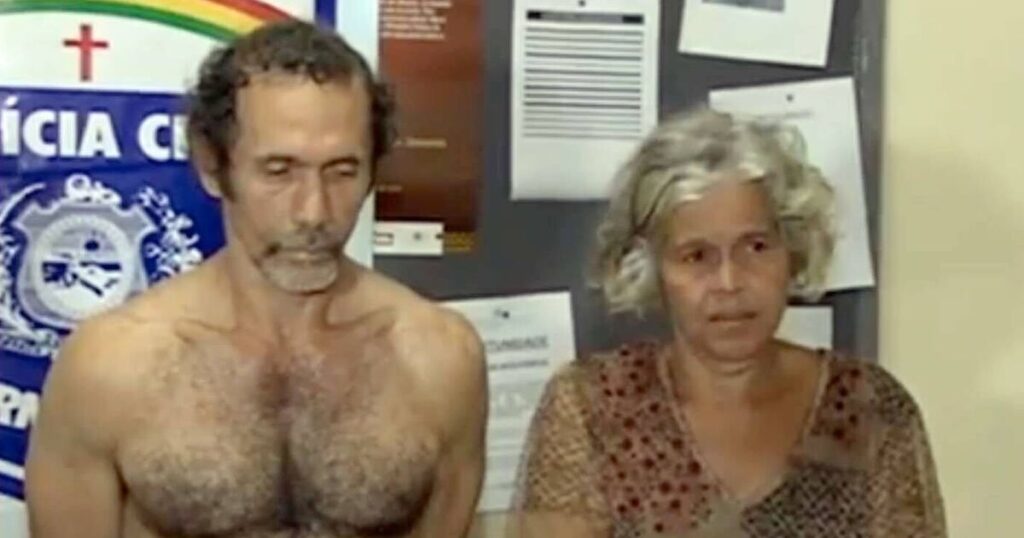‘Cannibal throuple’ sold victims as food and fed tot human flesh | World | News


Jorge and Isabel pictured after being arrested by Brazilian police. (Image: Mirror Screen Grab)
In the seemingly tranquil small town of Garanhuns, Pernambuco, Brazil, a gruesome tale unfolded.
Jorge Beltrão Negromonte da Silveira, together with his wife Isabel Cristina Pires and his mistress Bruna Cristina Oliveira da Silva – who all lived together – masterminded a string of heinous killings, partook in acts of cannibalism, and sold human flesh camouflaged as pies to the oblivious locals.
Their despicable exploits took an even darker turn when they adopted the young daughter of one of their victims.
The horrendous killing spree started in 2007 in Olinda, a city near Recife, the state’s capital. The trio operated within the shadows of a clandestine religious group they formed, dubbing it “O Cartel” (The Cartel), with Jorge at its helm proclaiming himself a spiritual guru with unique abilities.
He disseminated a corrupt ideology that justified the elimination of those deemed “evil” as a service to cleanse the world.
Their victims were often destitute women, ensnared by false promises of work, safety, and hope for a new life – a heinous charade they concocted repeatedly, reports the Mirror US.
Amongst the initial victims was Jéssica Camila, a 17 year old homeless girl from Olinda. The trio’s manipulative methods are laid bare in Bruna’s diary entries from March to July 2007, revealing the sinister manner in which they ‘conquered’ Jéssica with gifts and emotional manipulation, preying on her vulnerabilities, including her responsibility towards her young child.
Bruna’s diary entries reveal the intense psychological influence Jorge wielded, noting: “Monte [Jorge] advises me. His teachings are harsh, but I needed them to become the woman I am today… an eternal learner.”

Jorge Beltrao Negromonte da Silveira (Image: UGC)
Jorge himself later spoke of Jéssica as bright and “like a daughter” to him, yet it was Isabel who determined that Jéssica’s fate was doomed. It was Jorge who carried out the killing.
On the fateful night of June 26, 2008, Jorge throttled Jéssica amidst a dispute, then summoned Bruna to bring a knife. As Jorge pierced Jéssica’s jugular with the blade, Bruna pinned her down.
In a candid interview with the TV programme Conexao Reporter, Jorge elucidated the ritualistic nature of the mutilation: “The body is divided according to the four classical elements – water and earth are the legs; air and fire the arms; the fifth element, God, is the head. Each part is buried separately and blessed.”
He professed that this act was meant for “purification,” guided by voices he claimed to hear and the tenets of their cult. Despite the atrocity committed, Jorge maintained that he found no joy in the pain inflicted: “I felt only sadness and regret.”
Following Jéssica’s slaying, her dismembered remains were dispersed throughout the residence they shared in Olinda. Jéssica’s young daughter was then legally recorded as Jorge’s child, effectively “adopted” by the man responsible for her mother’s demise.
Following Jéssica’s death, a disturbing pattern began to emerge as two more young women fell victim to the sect’s sinister activities. Gisele Helena da Silva, known locally as Geisa do Papel, aged 25, and Alessandra Falcão, an unemployed 20 year old seeking a brighter future, met the same gruesome fate.
It wasn’t until 2012, years after the initial disappearances, that the police investigation finally gained momentum. Jorge and Bruna were caught on surveillance cameras using Gisele’s credit card at a local electronics store, sparking a more in-depth probe which would eventually expose the full extent of their heinous crimes.

The trio’s second murder victim, Giselly Helena (Image: Collect Unknown)
The evidence revealed the trio didn’t just murder their victims – they also cooked and devoured parts of their flesh as part of a twisted “purification” ritual. Jorge attempted to justify this barbaric practice as a means of “preventing it from rotting away”.
Bruna, who later confessed during police questioning, painted a chilling picture of the coercion she allegedly faced: “I had no choice. I was trapped, afraid, and I didn’t want to do any of this. I would never kill even a cockroach”.
“I had to comply, or I would be turned into a ‘coxinha'”, she claimed, referencing the group’s next depraved move. The human flesh was minced and cunningly concealed within traditional Brazilian pastries, known as coxinhas, which were then sold openly in Garanhuns.
These tainted treats were peddled in public areas, including near schools, hospitals, police stations, and bustling marketplaces, unknowingly exposing countless innocent people to the consumption of human meat. Jorge confessed to baking the pastries while Isabel took charge of sales.
Bruna described Isabel’s justification for their actions: “You have to eat, it’s the same as eating beef.”
Investigations later uncovered that these macabre pastries were sold widely during the trio’s operation.
Bruna’s personal diary entries and testimonies shed light on the menacing control Jorge exercised over her. Caught in a web of affection, terror, and coercion, she detailed feeling compelled to partake in heinous crimes amidst a battle to preserve her sense of self.
“I love Jorge but fear what he might do if we are together again,” she expressed.
In a deeply distressing revelation, Jéssica’s toddler daughter was listed under Jorge’s name and remained in the household following her mother’s slaying. The child, too, was entangled in the cult’s grim practices, fed food laced with human remains and made to bear witness, sometimes even take part in, the group’s savage rites.
Years on, the young girl’s input became crucial to the inquiry, leading officers to unearthed graves in the backyard of the Garanhuns property – a grim testament to the scale of their barbarity.
During the 2012 police bust on the Garanhuns residence, chilling proof emerged. Authorities dug up the remains of two victims in the rear garden, while bloodstains found in a washroom drainage system lent weight to accounts of the ritualistic killings and dismemberments perpetrated by the sect members.
Following the shocking revelations, Jorge, Isabel, and Bruna were taken into custody, facing rigorous questioning. Initially, Jorge refuted any involvement, blaming a mental disorder as he claimed to suffer from schizophrenia and paranoia in an attempt to distance himself from the deeds.
But as the pressure mounted, he eventually conceded: “I’m schizophrenic and paranoid. I wanted to deny who I was, but now I accept my guilt.”
In a bid to avoid blame, he admitted to coercing Bruna into adopting complete liability and to rehearse a fictitious account.

The trio’s third victim, Alessandra Falcao (Image: Mirror Screen Grab)
Throughout this ordeal, Isabel confessed her inability to confront Jorge, admitting her silence stemmed from love: “I loved him deeply.”
Their trial spiralled into one of Brazil’s most intricate and widely publicised judicial events. The defence leaned on arguments of mental instability and duress seeking leniency, while the prosecution depicted them as calculated murderers, motivated by extreme beliefs and sheer brutality.
The judgements were harsh – both Jorge and Bruna received over 70 years of imprisonment, with Isabel slightly less at 68 years, all assigned to closed-regime establishments.
The scandal sent shockwaves throughout Brazil dominating news cycles for an extended period, triggering immense concern and astonishment nationwide. The case also spotlighted the perils faced by those on the fringes of society vulnerable to predatory cults, emphasising the perilous intersection of zealotry and deceit.
The adult daughter of Jéssica Camila has come to represent the enduring impact of the trauma caused by the case. As a child, she was effectively “adopted” by the perpetrators, and now grapples with the lingering effects and stigma associated with her past.
In an attempt to break free, she has initiated legal proceedings to have Jorge’s name removed from her birth certificate.
According to her lawyer, she endured relentless bullying and discrimination, frequently being labelled “the cannibal’s daughter,” despite being an innocent victim herself since infancy.


